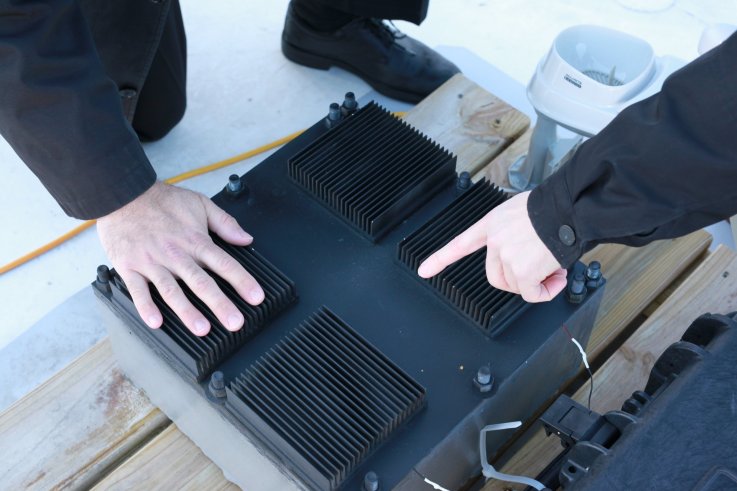
واحد مشترک کمکی پژوهش و مهندسی «هوش یار-تواندار» (HT-CSURE)
Hooshyar-Tavandar Common Subsidiary Unit for Research & Engineering
واحد مشترک کمکی پژوهش و مهندسی «هوش یار-تواندار» (HT-CSURE)
Hooshyar-Tavandar Common Subsidiary Unit for Research & Engineeringپیوندهای سایتهای علمی فناوری
پیوندهای علمی مختلف
سایتها و وبلاگهای عمومی
دستههای مطالب
- اخبار و تازه ها 2342
- اخبار فضا 114
- اخبار و تازه های فناوری 2312
- مطالب و مقالات جالب و مفید مرتبط به فناوری 59
- اخبار عمومی فناوری 32
- پیشرفتهای فناوریهای نظامی 102
- اخبار و مطالب مرتبط با فناوریهای مرتبط با ایده ها و اهداف واحد 2286
- اخبار و مطالب روباتیک و هوش مصنوعی 414
- انرژیهای نو و سبز+ روشهای تازه انتقال یا تولید یا ذخیره 214
- سوخت زیستی 35
- انرژی خورشیدی 60
- همجوشی 10
- بازیافت انرژی 21
- باد و جابجایی هوا و سیال 22
- ذخیره انرژی؛ باتری و ... 18
- انرژی حرارتی 5
- سفر و سکونت در جاهای بکر و فضا 266
- روشهای تازه تولید خوراک 332
- ساخت سازه ها و سکونتگاهها 644
- ساختمان هوشمند 70
- ساختمانهای پیش ساخته و جدید 91
- ساخت مسکن و سکونتگاههای ارزان 202
- کاروان 56
- پناهگاه 58
- ساخت مهاجرنشین+مراکز جمعیتی جدید 402
- پرینترهای 3D = سه بعدی 23
- وسایل نقلیه جدید و سازگار با محیط زیست 211
- پژوهشهای پزشکی و زیستی 713
- فناوریهای پوشیدنی 130
- اخبار و مطالب عمومی فناوری اطلاعات 204
- اخبار و مطالب درپیوند با نرم افزار 77
- آینده پژوهی علمی فناوری زیستی 855
- پرواز 131
- پروژه های جاری 120
- اسباب بازی و ماکت 82
- محیط زیست کوچک و بزرگ 531
- مکانیک و مواد 53
- کسب و کار و کارآفرینی 424
- نانو فناوری 8
- ساخت خودرو 36
- ساخت کشتی و شناور 14
- ساخت هواپیما و فضاپیما 19
- مطالب و مقالات متفرقه جالب و مفید 2808
- بهداشت، سلامت، پزشکی 1048
- فرهنگی، اجتماعی، سیاسی و نظامی، مذهبی 1997
- سیاسی و نظامی 876
- فرهنگی 781
- اجتماعی 1466
- مذهبی 610
- آینده پژوهی فرهنگی، اجتماعی، سیاسی، نظامی 1020
- فلسفی 159
- آینده پژوهی مذهبی، انتظار ظهور و آخرالزمان و مرتبط 465
- اقتصادی 500
- مطالب درپیوند با پژوهش 16
- روان شناسی 296
- علمی - تخیلی 34
- استوره ای (اسطوره ای) - تاریخی 39
- علوم 109
- ورزش 118
- واحد 31
- مجموعه پیوندها 20
- کاربردی 15
- سرگرمی 98
- آموزشی 85
- الکترونیک 13
- روباتیک 11
- هوش مصنوعی 20
- مکانیک 11
- کامپیوتر (رایانه) 23
- مهندسی عمران و ساختمان 2
- فیزیک 4
- عمومی 20
برگهها
جدیدترین یادداشتها
همه- اگر عمر 100 ساله می خواهید به منطقه آبی و روش های آن ها توجه کنید! (+عکس)***
- عید نوروز مبارک
- طرح احتمالی مزارع غولپیکر و عجیب امارات برای بارش باران
- شهادت تسلیت
- خوردن بیش از اندازه ویتامینهای خانواده "ب" خوب نیست
- تقویم سال 1403 هجری خورشیدی
- فواید نوشیدنِ همواره ی چای زنجبیل
- کاهش التهاب بدن با 6 ویتامین ضد التهاب ***
- انقلاب بزرگ هوش مصنوعی در دنیای شبکه/ پیامدها بر کسب و کارها
- میکرولینو؛ آیپد دنیای خودرو، چیزی بین موتورسیکلت و اتومبیل (+عکس)
- میلاد مبارک
- یک اندیشکده بریتانیایی: عصر بیثباتی فزاینده در جهان آغاز شده است
- نوشته ای درباره اینکه چگونه متفاوت و خاص زندگی کنیم ؟
- دانشمندان یک غذای جدید ابداع کردند: برنج گوشتی
- جلبک دریایی میتواند «غذای آخرالزمان» باشد
- یک خودروی 3 چرخه تازه با موتور الکتریکی
- چگونگی ساخت یک توربین کوچک بادی ساده و کم هزینه برای تولید برق رایگان
- ایلان ماسک: تا دو دهه دیگر یک میلیارد ربات انسان نما در زمین خواهد بود(!؟)
- نکاتی درباره شناخت مزاج و سفارشهای خوراکی برای هر مزاج در طب سنتی
- ربات خدمتکار مجهز به هوش مصنوعی از راه می رسد
- آشنایی با ورق آهن
- غذای خام بخوریم یا پخته؟ کدام بهتر است؟
- گامهایی به سوی به واقعیت رسیدن جابجایی کوانتومی اطلاعات همچون فناوری «پیشتازان فضا»
- ۶ فایده شگفتانگیز این گیاه معطر؛ از کاهش عفونت تا نابودی سرطان ***
- ۸ علامت هشداردهنده سرطان را بشناسید
- این دمنوشها نابودگر عفونت در بدن هستند
- پیشرفتهای تازه ای در آزمایشهای ساخت رآکتورهای همجوشی
- بهترین نرمافزارهای آنتیویروس رایگان
- ساخت تصاویر ذهنی با کمک هوش مصنوعی
- شهادت تسلیت
- دمنوش بابونه برای پیشگیری از سرماخوردگی بسیار خوب است
- پدربزرگ کمپرهای امروزی (عکس)
- ژاپنی ها با فضولات گاو سوخت موتور موشک ساختند***
- رونمایی تسلا از نسل دوم ربات انساننما
- اصلاحات از منظر قرآن کریم
- بررسی و شناخت مفهوم اصلاح و اصلاحگری از دیدگاه دین اسلام
- اصلاح و اصلاحگری از دیدگاه قرآن
- بنیانگذار «ویکیپدیا»: هوش مصنوعی هنوز دستکم ۵۰ سال دیگر میتواند به ابرانسان تبدیل شود
- اولین ربات زنده (زیستی) جهان ساخته شد
- آیا شما میتوانید بنیانگذار استارتآپ موفق بعدی باشید؟***
- افشاگری نیویورک تایمز/ مرگ و زندگی آدمها در اختیار هوش مصنوعی***
- کمال غفاریان؛ رقیب ایلان ماسک و جف بزوس***
- روشهایی برای کمک به هوش***
- بهترین خودروهای ۶ چرخ تاریخ ***
- معنویت در جهان بیمعنا؛ مصاحبه با دکتر بیژن عبدالکریمی
- آشنایی با فلسفه و اندیشه های مونتنی
- معرفی چند راهکار مفید برای مراقبت از خود***
- خاورمیانه در پرتگاه جنگ قرار دارد؟***
- شاهکار جدید هوش مصنوعی در سیاره مریخ***
- بهترین کشورهای جهان برای کار از راه دور***
بایگانی
جستجو
New Device Can Generate Power Anytime and Anywhere Just From Changes in Temperature
Scientists have created an entirely new way to generate electricity—anytime, anywhere. The device, known as a thermal resonator, can harness energy from temperature fluctuations happening all around us. Scientists from the Massachusetts Institute of Technology are working on accessing this "untapped energy source," which can function regardless of rain or shine, according to the new study's senior author, Michael Strano.
The unusual source of energy is drawn from the natural ebbs and flows of temperatures. The most obvious fluctuations, Strano said, are the changes between day and night. Large changes such as those generate the most power, but even minute temperature differences all around us can generate electricity.

"We're actually surrounded by temperature fluctuations," Strano said. Sometimes, the temperature changes slowly, like outside—it changes over a 24-hour cycle. But even around the human body, if you were to carry a thermometer in your pocket, you would find it fluctuating every few seconds."
These temperature changes are constant and surround us everywhere we go, Strano explained. "We sit in a giant temperature bath, and when that bath fluctuates, you basically can generate electrical power," he said.
The thermal resonator, which appears like a black box, can use those constant temperature changes to generate electricity through a special material created at MIT. The material is made from metal foam coated in graphene and combined with a wax called octadecane, as detailed in the researchers' study published mid-February in Nature Communications. The thermal resonator is filled with this material, which can both absorb and store heat.

After months of testing on the roof of an MIT building, researchers discovered that enough electricity could be generated to power LED lights, small computers and even batteries. Because the device works regardless of whether it is sunny or not, it has an advantage over solar power, too. Clouds, winds, or even sand, which often covers up solar panels in the middle of deserts, wouldn't affect its ability to harness power from the ever-changing temperatures. The device could even be retrofitted beneath a solar panel, bolstering the energy potential. This way, excess heat with energy potential isn't wasted.
It could be used in a variety of ways too. Since the material incorporated into the box isn't delicate or made from fragile parts, it could be buried underground or incorporated into building structures. The device could go as far as other moons or planets, powering up landers and rovers with just enough power to keep moving, but lasting long enough for space missions.

It's a new field, Strano noted, but as more scientists continue to work on this way of generating power, more electricity could eventually be generated. Strano and his team have been researching this power source for around one year, and they are already thinking of starting a company to eventually commercialize the thermal resonator. This way of generating power is "more than just an invention," said Strano. "It's a new mechanism for generating electrical power."


























